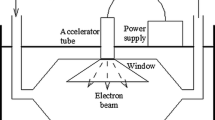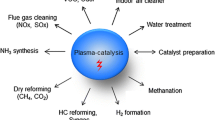Abstract
To date, numerous studies have investigated the aftertreatment of exhaust gases from fossil-fueled combustors and combustion engines by plasmas as an environmental plasma application. Owing to the high power requirements of environmental plasma, it is difficult to use the plasma alone for aftertreatment; hence, a hybrid process that combines plasma processing with other techniques is required to reduce the overall power consumption. In developing countries, low-cost plasma hybrid processing has attracted considerable attention as an alternative to the selective catalytic reduction NOx decomposition (De-NOx) method and wet lime–gypsum SOx decomposition method. Moreover, reduced catalytic activity can be enhanced by the plasma because of the decreased exhaust gas temperature, owing to the increased combustion efficiency. This paper reviews studies on successful air pollutant decomposition processes using the plasma chemical process with scale-up reactors. First, experimental techniques and block diagrams of various environmental plasma systems are presented. Subsequently, real-world systems of scale-up plasma reactors are described in detail. Several experimental results suggest that the hybrid treatment of particulate matter and dry De-NOx is very promising from the viewpoint of energy consumption and material recycling. CO2 treatment is a very important direction for future work in environmental plasma.





















Similar content being viewed by others
References
Okubo M, Kuwahara T (2019) New technologies for emission control in marine diesel engines. Butterworth-Heinemann, Elsevier
Zhu J, Zhao Q, Yao Y, Luo S, Guo X, Zhang X, Zeng Y, Yan K (2012) Effects of high-voltage power sources on fine particle collection efficiency with an industrial electrostatic precipitator. J Electrostat 70:285–291
China Environmental Protection, National Quality Supervision, (2011) Inspection and quarantine: thermal power plant air pollutants emission standards (GB-13223-2011)
Adachi M, Kosaka H, Fukuda T, Ohashi S, Harumi K (2014) Economic analysis of trans-ocean LNG-fueled container ship. J Mar Sci Technol 19:470–478
Winterthur Gas & Diesel Ltd. (2018) Selective catalytic reduction FAQ. https://www.wingd.com/en/documents/general/brochures/wingd-scr-technology-faq.pdf/
Schmieg SJ (2010) Aspects of HC-SCR catalyst durability for lean-burn engine exhaust aftertreatment. SAE Paper 2010–01–2160
Spencer LF, Gallimore AD (2011) Efficiency of CO2 dissociation in a radio-frequency discharge. Plasma Chem Plasma Process 31:79–89
Fujishima H, Takekoshi K, Kuroki T, Tanaka A, Otsuka K, Okubo M (2013) Towards ideal NOx control technology for bio-oils and a gas multi-fuel boiler system using a plasma-chemical hybrid process. Appl Energy 111:394–400
Fujishima H, Yoshioka Y, Kuroki T, Tanaka A, Otsuka K, Okubo M (2011) Development of low-emission bio-fuel boiler system with plasma-chemical hybrid NOx reduction. IEEE Trans Ind Appl 47:2210–2217
Fujishima H, Tatsumi A, Kuroki T, Tanaka A, Otsuka K, Yamamoto T, Okubo M (2010) Improvement in NOx removal performance of the pilot-scale boiler emission control system using an indirect plasma chemical process. IEEE Trans Ind Appl 46:1722–1729
Fujishima H, Kuroki T, Ito T, Otsuka K, Yamamoto T, Yoshida K, Okubo M (2010) Performance characteristics of pilot-scale indirect plasma and chemical system used for the removal of NOx from boiler emission. IEEE Trans Ind Appl 46:1707–1714
Simachev VY, Novoselov SS, Svetlichnyi VA, Gavrilov AF, Gorokhov MV, Semenov VI, Ryzhikov VA, Demchuk VV (1988) An investigation of the ozone-ammonia method of simultaneous desulphurisation and denitrification of flue gases when burning Donetsk coals. Thermal Eng (Translated from Teploenergetika) 35:67–70
Yasuda M, Tsugita N, Iubto K, Yamauchi S, Glomm WR, Tsuji I, Asano H (2011) High-efficiency NOx absorption in water using equipment packed with a glass fiber filter. Environ Sci Technol 45:1840–1846
Yamamoto H, Kuroki T, Fujishima H, Okubo M (2019) Pilot-scale NOx and SOx aftertreatment using a two-phase ozone and chemical injection in glass-melting-furnace exhaust gas. IEEE Trans Ind Appl 55:6295–6302
Yamasaki H, Mizuguchi Y, Nishioka R, Fukuda Y, Kuroki T, Yamamoto H, Okubo M (2021) Pilot-scale NOx and SOx after treatment by semi-dry plasma-chemical hybrid process in glass-melting-furnace exhaust gas. Plasma Chem Plasma Process. https://doi.org/10.1007/s11090-021-10193-4
Kuwahara T, Yoshida K, Kuroki T, Hanamoto K, Sato K, Okubo M (2014) Pilot-scale aftertreatment using nonthermal plasma reduction of adsorbed NOx in marine diesel-engine exhaust gas. Plasma Chem Plasma Process 34:65–81
Kuwahara T, Yoshida K, Kuroki T, Hanamoto K, Sato K, Okubo M (2019) High reduction efficiencies of adsorbed NOx in pilot-scale aftertreatment using nonthermal plasma in marine diesel-engine exhaust gas. Energies 12:3800
Kuwahara T, Yoshida K, Kuroki T, Hanamoto K, Sato K, Okubo M (2020) Pilot-scale combined reduction of accumulated particulate matter and NOx using nonthermal plasma for marine diesel engine. IEEE Trans Ind Appl 56:1804–1814
Masui M, Hayakawa Y, Takeyama A, Miura T, Kambara S (2014) Low temperature SNCR tests by injection of activated ammonia generated by DBD. In: Proceedings of the ISEHD 2014 Okinawa, Japan
Hayakawa Y, Inoue Y, Takeyama A, Kambara S (2016) Reaction mechanism of De-NOx by activated ammonia generated by dielectric barrier discharge. Int J Plasma Environ Sci Technol 10:20–23
Ma S, Zhao Y, Yang J, Zhang S, Zhang J, Zheng C (2017) Research progress of pollutants removal from coal-fired flue gas using non-thermal plasma. Renew Sustain Energy Rev 67:791–810
Chang JS, Urashima K, Tong YX, Liu WP, Wei HY, Yang FM, Liu XJ (2003) Simultaneous removal of NOx and SO2 from coal boiler flue gases by DC corona discharge ammonia radical shower systems: pilot plant tests. J Electrostat 57:313–323
Han B, Kim HJ, Kim YJ (2015) Removal of NO and SO2 in a cylindrical water-film pulse corona discharger. IEEE Trans Ind Appl 51:679–684
Mok YS, Nam IS (1999) Positive pulsed corona discharge process for simultaneous removal of SO2 and NOx from iron-ore sintering flue gas. IEEE Trans Plasma Sci 27:1188–1196
Lee Y-H, Jung W-S, Choi Y-R, Oh J-S, Jang S-D, Son Y-G, Cho M-H, Namkung W, Koh D-J, Mok Y-S, Chung J-W (2003) Application of pulsed corona induced plasma chemical process to an industrial incinerator. Environ Sci Technol 37:2563–2567
Winands GJJ, Liu Z, Pemen AJM, van Heesch EJM, Yan K, van Veldhuizen EM (2006) Temporal development and chemical efficiency of positive streamers in a large scale wire-plate reactor as a function of voltage waveform parameters. J Phys D Appl Phys 39:3010–3017
Hołub M, Kalisiak S, Borkowski T, Myśków J, Brandenburg R (2010) The influence of direct non-thermal plasma treatment on particulate matter (PM) and NOx in the exhaust of marine diesel engines. Pol J Environ Stud 19:1199–1211
Balachandran W, Manivannan N, Beleca R, Abbod M (2015) Reduction of NOx and PM in marine diesel engine exhaust gas using microwave plasma. J Phys Conf Ser 646:012053
Balachandran W, Manivannan N, Beleca R, Abbod M, Brennen D, Alozie NS, Ganippa LC (2016) Nonthermal plasma system for marine diesel engine emission control. IEEE Trans Ind Appl 52:2496–2505
Hueso JL, González-Elipe AR, Cotrino J, Caballero A (2007) Removal of NO in NO/N2, NO/N2/O2, NO/CH4/N2, and NO/CH4/O2/N2 systems by flowing microwave discharges. J Phys Chem A 111:1057–1065
Masuda S, Nakao H (1990) Control of NOx by positive and negative pulsed corona discharges. IEEE Trans Ind Appl 26:374–383
Clements JS, Mizuno A, Finney WC, Davis RH (1989) Combined removal of SO2, NOx, and fly ash from simulated flue gas using pulsed streamer corona. IEEE Trans Ind Appl 25:62–69
Chapter 3 on pp. 47–90 of Ref. 1
Li S, Huang Y, Wang F, Liu J, Feng F, Shen X, Zheng Q, Liu Z, Wang L, Yan K (2014) Fundamentals and environmental applications of non-thermal plasmas: multi-pollutants emission control from coal- fired flue gas. Plasma Chem Plasma Process 34:579–603
Dinelli G, Civitano L, Rea M (1988) Industrial experiments on pulse corona simultaneous removal of NOx and SO2 from flue gas. IEEE Ind Appl Society of Annual Meeting Conf Rec, pp 1620–1627
Du C, Gong X, Lin Y (2019) Decomposition of volatile organic compounds using corona discharge plasma technology. J Air Waste Manage Assoc 69:879–899
Zhang J, Liu Y, Yao X, Shao Q, Xu B, Long C (2020) Enhanced moisture resistance of Cu/Ce catalysts for CO oxidation via plasma-catalyst interactions. Chemosphere 261:127739
Xu H, Luo J, Chu W (2014) Non-thermal plasma-treated gold catalyst for CO oxidation. RSC Adv 4:25729
Iuni T, Yoshida M, Koizumi K, Kawakami H (2013) PM reduction technology with electrostatic precipitator for marine use. J Jpn Inst Mar Eng 48:534–539 (in Japanese)
Kuwahara T, Yoshida K, Hanamoto K, Sato K, Kuroki T, Okubo M (2015) A pilot-scale experiment for total marine diesel emission control using ozone injection and nonthermal plasma reduction. IEEE Trans Ind Appl 51:1168–1178
Kuwahara T, Yoshida K, Hanamoto K, Sato K, Kuroki T, Yamamoto T, Okubo M (2012) Pilot-scale experiments of continuous regeneration of ceramic diesel particulate filter in marine diesel engine using nonthermal plasma-induced radicals. IEEE Tran Ind Appl 48:1649–1656
Fan R, Cai Y, Shi Y, Cui Y (2019) Effect of the reaction temperature on the removal of diesel particulate matter by ozone injection. Plasma Chem Plasma Process 39:143–163
Lee DH, Kim H, Song Y-H, Kim K-T (2014) Plasma burner for active regeneration of diesel particulate filter. Plasma Chem Plasma Process 34:159–173
Higashi M, Uchida S, Suzuki N, Fujii K (1992) Soot elimination and NOx and SOx reduction in diesel-engine exhaust by a combination of discharge plasma and oil dynamics. IEEE Trans Plasma Sci 20:1–12
Fushimi C, Madokoro K, Yao S, Fujioka Y, Yamada K (2008) Influence of polarity and rise time of pulse voltage waveforms on diesel particulate matter removal using an uneven dielectric barrier discharge reactor. Plasma Chem Plasma Process 28:511–522
Rusanov VD, Fridman AA, Sholin GV (1981) The physics of a chemically active plasma with non-equilibrium vibrational excitation of molecules. Sov Phys Usp 24:447–474
Nunnally T, Gutsol K, Rabinovich A (2011) Dissociation of CO2 in a low current gliding arc plasmatron. J Phys D Appl Phys 44:274009
Okubo M, Takahashi K, Kamiya S, Kuroki T (2018) High-efficiency carbon dioxide reduction using nonthermal plasma desorption. IEEE Trans Ind Appl 54:6422–6429
Matsukuma Y, Sadagata K, Kakigami H, Inoue G, Minemoto M, Yasutake A, Oka N (2006) Simulation of CO2 recovery system from flue gas by honeycomb type adsorbent II: Optimization of CO2 recovery system and proposal of actual plant. Kagaku Kogaku Ronbunshu 32:146–152 (in Japanese)
Yoshida K, Yamamoto T, Kuroki T, Okubo M (2009) Pilot-scale experiment for simultaneous dioxin and NOx, removal from garbage incinerator emissions using the pulse corona induced plasma chemical process. Plasma Chem Plasma Process 29:373–386
Ren Y, Li X, Yu L, Cheng K, Yan J, Du C (2013) Degradation of PCDD/Fs in fly ash by vortex-shaped gliding arc plasma. Plasma Chem Plasma Process 33:293–305
Acknowledgements
Much of the research presented in this review was conducted through a collaboration by Dr. Tomoyuki Kuroki, Dr. Takuya Kuwahara, Dr. Haruhiko, Yamasaki, and Dr. Hidekatsu Fujishima of Osaka Prefecture University, Dr. Keiichiro Yoshida of Osaka Institute of Technology, Dr. Hashira Yamamoto of Nihon Yamamura Glass Co., Ltd., Kenichi Hanamoto and Kazutoshi Sato of Daihatsu Diesel MFG. Co., Ltd., and Keiichi Otsuka and Atsushi Tanaka of Takao Iron Works Co., Ltd.
Funding
This work is supported by JSPS KAKENHI Grant Number JP20H02374.
Author information
Authors and Affiliations
Corresponding author
Ethics declarations
Conflict of interest
The author declares that he has no known competing financial interests or personal relationships that may have appeared to influence the work reported in this paper.
Additional information
Publisher's Note
Springer Nature remains neutral with regard to jurisdictional claims in published maps and institutional affiliations.
Rights and permissions
About this article
Cite this article
Okubo, M. Recent Development of Technology in Scale-up of Plasma Reactors for Environmental and Energy Applications. Plasma Chem Plasma Process 42, 3–33 (2022). https://doi.org/10.1007/s11090-021-10201-7
Received:
Accepted:
Published:
Issue Date:
DOI: https://doi.org/10.1007/s11090-021-10201-7




